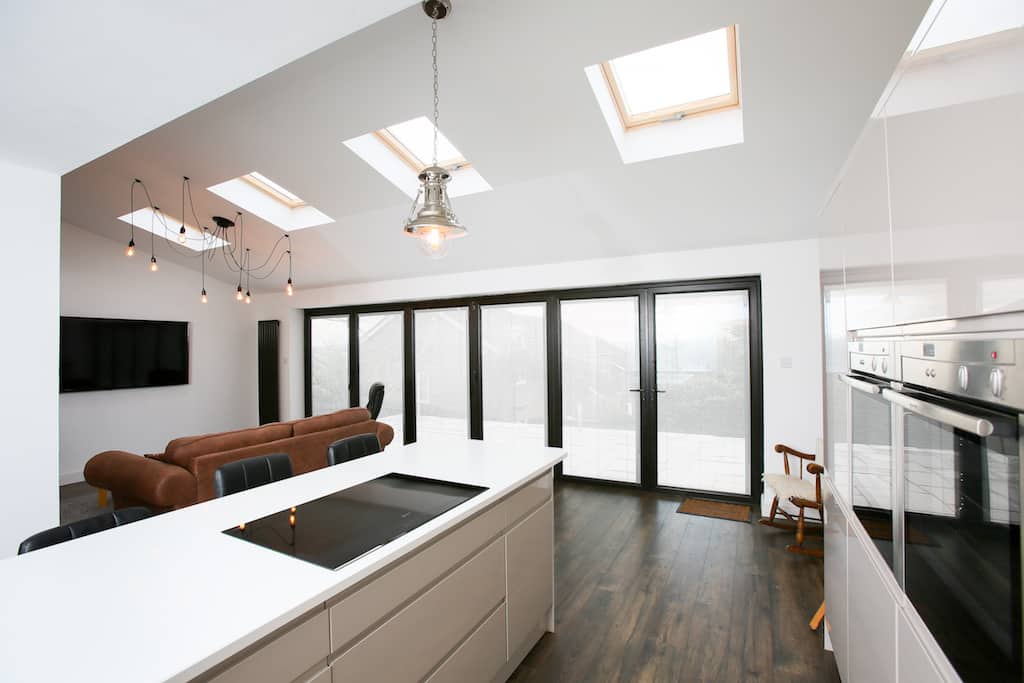Epwin Window Systems has a new aluminium product, the Integral bifolding door. If you don’t know of The Epwin Group, they are a substantial PVCu manufacturer. Founded in 1976, The Epwin Group is listed on the London Stock Exchange. Epwin predominantly serves the trade, retail, social housing and construction sector.

What is the Integral Bifolding door by The Epwin Group?
The Integral bifolding door is an aluminium bifold targeted at a relatively new niche in the market. That is the aluminium bifolding door with similar aesthetics to PVCu windows. The excellent Alumina bifolding door by Liniar is already selling well as a premium aluminium bifold with the woodgrain foils and aesthetics to match PVCu windows.
What Epwin do not say with their Integral product is whether, like Liniar, it matches any of their window suites. Our research presently indicates it does not and it’s very much a stand-alone bifold in the overall range of Epwin products.
Epwin windows say in their press releases:
“Bifold doors are a booming sector but to date there has always been a problem in that aluminium doors simply don’t suite with existing PVCU windows – our new Integral bifold door solves this problem. The doors have the strength and performance of an aluminium bifold but with PVCU detailing.”
The external frame and sash upstand are available in a bevelled or sculptured finish as is the beading, to complement the style of a property’s windows. There’s also the option of a square aluminium bead.”
Several bifold door systems on the market already offer a rounded aesthetic inside or outside, similar to PVCu windows and doors. However where aluminium bifolding doors do differ is they don’t come with a PVCu foil. Origin bifolding doors come with a woodgrain sublimated aluminium finish as do Smart Systems Visofold doors with their woodstructure range. That said, a substantial number of houses have modern PVCu windows installed not needing replacement. As a result, the Integral bifold door by Epwin and a door like Liniar’s Alumina offer a true PVCu aesthetic and the benefits of an aluminium bifolding door.
Key Features of Epwin Group’s Integral bifolding door.
Epwin says the Integral bifold is developed for appearance and design flexibility. You get a bevelled frame and sash upstand as well as an optional square. You also get a PVCu glazing bead. There are some advantages to having PVCu beads on a door like this. First of all, you get a choice of sculptured or bevelled, as well as square aluminium versions.
One benefit of PVCu glazing beads is their greater ‘give’ over aluminium beads. They are more flexible, therefore making the doors easier to glaze. Also, they reduce the risk of marking the paint finish with the exposed edges sometimes found in aluminium glazing beads cut a little oversize. Careful glazing and the right size cut beads usually don’t pose a problem. However, it is useful for the harsher or inexperienced glazier.
Just like any aluminium bifolding door, Integral uses polyamide thermal breaks. At the moment little information is available on the choice of door profiles, cills and ancillaries available. We envisage a range of cill sections, add-on for trickle vents and the usual frame extension pieces. The door should also come with a standard and low threshold.
Bifolding door configurations and options.
Integral comes as a two-panel to seven panel arrangement. Door leaves come in sizes of 750mm up to 1000mm wide with a maximum sash height of 2100mm. As with any other bifold, doors open in or out, come with an access leaf and flexible folding sliding options. You also get a single or double door option as a basic hinged door.
The door is suitable to replace old bifolding doors thanks to a 70mm deep profile. This dimension is also good for the majority of other PVCu systems, mostly with the same dimension.
Performance Specifications.
- PAS24 security tested as well as Secured by Design and Document Q Compliant, only when correctly specified.
- Multi-point locks with anti-lift system and shoot bolts to the slave leaves.
- The standard 40-micron powder coated finish.
- Typical U-Values of 1.7Wm2K, available with double or triple glazing.
Colour options with Integral folding doors.
As with any other bifold, you get a choice of colour. Epwin offers a choice of Black, white or grey standard colours. Then you get a selection of foiled finishes. All in all, there are 28 foil colours and woodgrain finishes
Integral vs Alumina bifolding doors.
Our at a glance table shows the key features of the new Integral bifolding door against the Alumina product – its obvious competitor. Here is how they compare. You can also read our in-depth review of the Alumina bifolding door.
| Feature | Integral Bifolding Door | Alumina Bifold Door |
|---|---|---|
| Product Guarantee (from installers) | 10 years | 10 years |
| Matches whole system | No | Yes |
| Handle Colour Options | Three | Five |
| Square or round edge profiles | Beads only | Yes |
| Single and Double Doors | Yes | Yes |
| Standard RAL Colours | White, Black, Grey | White, Black, Grey |
| Woodgrain Colours | Yes | Yes |
| Door availability | Approved Installers | Approved Installers |
| Anti-finger trap feature | Standard | Standard |
| Traffic Door Option | Yes | Yes |
| Maximum panel size | 1000x2400mm | 1200×2500 |
| Security Certification | PAS 24 | PAS24 |
| Threshold Options | Two | Three |
| Weather rated low threshold | No | Yes & Part M. |
| Typical Double Glazed U-Value | 1.7Wm2K | 1.5Wm2K |

Summary. What we think of the Integral Bifolding Door.
When as a business, your core focus for more than forty years is PVCu products, designing an aluminium bifold requires a different approach. In designing the Integral door, we think Epwin missed out on a big opportunity to offer a bifolding door with at least the expected features found in many aluminium doors already as well as some new ones.
For instance, the door leaves don’t go large or tall enough compared to even ‘builders favourite’ cheaper systems like Visofold. This means the door will have to have four leaves where other doors accommodate three. Furthermore, there is no ramp-type threshold, and the handle colour options are too limited if their brochure is anything to go by.
By comparison, the Alumina bifold seems a better designed and thought out proposition compared to the Epwin Group offering. It comes with bigger door sizes, more hardware colour options and a far more flexible choice of thresholds. Alumina comes with the option of a weather rated and Part M threshold. Alumina also offers a one system solution for many homeowners, even down to matching trims and accessories.
Finally, we think there is too much emphasis on the door as a solution to match a PVCu window. Given the sheer number of aluminium bifolds in a contrasting colour in houses with existing PVCu windows, we would question whether this is even an issue for homeowners?
However, like Liniar’s Alumina it does appeal to those wanting to match their PVCu products. We certainly don’t agree with the ‘aluminium can be clinical’ message in Epwin’s press releases for the product. The Epwin Group is a stand-out company in the fenestration sector. What the market is missing is a foiled aluminium bifold door with flat profiles like the Schuco door as well as the sculptured appearance.
The Integral Bifold door joins a now mature market and worthy of consideration alongside other brands. Presently the Alumina offers more when comparing these two bifolds side by side.
Nonetheless, you get a product from an established and excellent company, also meeting the latest industry standards and specifications.










